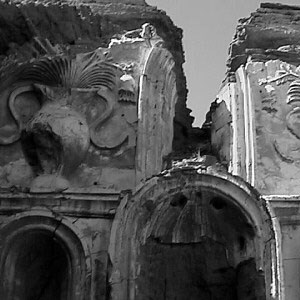
By Ginny Sphar
Father Rafael Díaz was born October 24, 1794, in the wine making center of Jerez de la Frontera, north of Cádiz, Spain. He may have emigrated to New Spain with his family during the long French troubles. He entered the Franciscan Order in the province of Michoacan, Mexico, two days after his twenty-fourth birthday. In 1820 he transferred to the College of Querétaro. Four years later he was assigned to San Xavier del Bac as a replacement for Father Juan Vaño. From 1824 until the expulsion in 1828 he did double duty as missionary at San Xavier and interim chaplain at the Tucson garrison. In 1825 he had been carried to Tumacácori, very ill. While he was ill at Tumacácori, three women of Tucson presidio died without sacraments. Fearing he might be charged unjustly with neglecting his duties, Díaz asked three of the community’s leading citizens to testify in his behalf. The week of November 20, 1825, the three signed identical statements for the bishop, praising Díaz as a pastor. As for the three women who died, one died suddenly and the other two had been remiss in not summoning Father Liberós.[1] Father Díaz was a naturalized Mexican but was not too certain of his status, although he had resided in Mexico for a decade. Father Rafael was one of two Spanish Franciscan priests who stayed when the rest of the Franciscans left during the expulsion of Spaniards by the Mexican government in 1828. Díaz secured a permit to remain in Mexico. There were two Franciscans left, Díaz and Father José Maria Pérez Llera. They divided Pimería Alta into two sections. Llera took San Ignacio and the west, Tubutama, Oquitoa and Caborca and their visitas. Sáric was already abandoned. Díaz took the north, Cocóspera, Tumacácori, San Xavier plus the presidios of Santa Cruz, Tubac and Tucson. Never again would the missions be fully manned. The days of the resident missionary protector had passed.[2] Later in 1828 there were now four missionaries in Pimería Alta.
1. José María Pérez Llera (Father President of the College of Querétaro) at San Ignacio. 2. Rafael Díaz residing at Cocóspera and ministering to Tumacácori, San Xavier and the presidios of Santa Cruz, Tubac and Tucson. 3. Juan Maldonado serving Oquitoa and Tubutama. 4. Faustino González at Caborca.
In 1832 the four Franciscans gathered at Magdalena to dedicate a church that Pérez Llera had built. They obviously needed more help. If they recruited a few more friars, they could set up a school to train youths to assist them. Llera added three rooms at Magdalena and asked for government aid. In 1833 Father Llera made the long trip to Querétaro to enlist more missionaries. He found only two—Father Antonio González and Father Ángel de la Conceptión Arroyo. Father Díaz, on November 1, 1832, described the plight of the Indian families who hung on in the area despite drought, famine and Apaches. Lack of defense of Cocóspera and Tumacácori perplexed him. The presidial forces of Santa Cruz and Tucson ignored his urgent plea for help. By 1834 things were very bad because of the Apaches. They heard the Apaches were coming to Tubac. The few settlers were poorly armed—the garrison could only muster 10-12 men. Tubac was at the mercy of the Apaches. If additional troops were not assigned to Tubac, the settlers would have to leave. By now Díaz had had it with Pimería Alta. He wanted a transfer to New Mexico. That failed. He could not be everywhere at once. He decided to reside at Cocóspera and ride the circuit down the river from the presidio of Santa Cruz to the presidio of Tucson, a 100-mile trip one way. Whenever he could he would stop at Tumacácori. By 1836 the mission roster was thus:
José María Pérez Llera San Ignacio Rafael Díaz Cocóspera Antonio González San Xavier Juan Maldonado Oquitoa Faustino González Pitiquito Ángel Arroyo Caborca
Within five years only two were left. In 1837 Rafael Díaz moved from Cocóspera to San Ignacio to fill in for Father Llera who left the frontier. From 1837 until his death in 1841, Díaz was pastor to the entire northern Pimería, from San Ignacio to the presidio of Tucson. The remnants of the Pimas and Papagos at Tumacácori rarely saw a priest.[3] Pérez Llera named Díaz Father President of the College in 1841, but Díaz, the last Spaniard, had taken to his bed. He announced his appointment to Antonio González at Oquitoa and Ángel Arroyo at Caborca and at the same time told them that the bishop had stripped them of their duties.[4] Not yet 47, Father Díaz died in the summer of 1841. [1] Statements by Manuel de León, Ramiréz, and José León, Tucson. [2] Pérez Llera, Apuntes, November 20 and 26, 1825, AMS. [3] Ibid., pp. 288-94, 806-10. [4] Díaz to González and Arroyo, May 28, 1841. Flores to Gándara, Opodepe, August 7, 1841, AES. Antonio González signed the inventory for San Ignacio on September 7, 1841. BL, M-M 380, No. 65. |
Last updated: May 6, 2025
